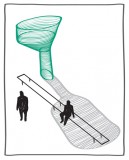Supervisor:
2012
This paper is a scalable route, which, starting from the identification of modern urban environment problems, goes in an effort to interpret the way they affect the usage of open urban spaces. What follows is a comprehensive presentation of methods and tools used to improve thermal, acoustic and visual comfort of the people using open urban spaces. The completion of this route is marked by the presentation of a piece of urban equipment designed by the writer in order to improve the thermal comfort conditions of open spaces in warm city climates.
More specifically, the work is divided into three main parts. The first part analyzes key environmental problems such as noise pollution and the phenomenon of urban heat island. A presentation of the definitions of visual, acoustic and thermal comfort follows in orden to find out whether or not the problems stated above are responsible for the desertification of open urban spaces.
The second part is a presentation of some under-study and applied methods and tools used in several cities around the world in order to improve comfort conditions in open urban space. Studies are presented sequentially starting with poleodomic studies, continuing with the analysis of specific public spaces like parks and squares and concluding with the presentation of some urban equipment units designed to attract people to use their city by improving the microclimate.
Finally in the third part, using information and knowledge gathered in the earlier sections, a piece of urban equipment able to improve thermal comfort of public space users is designed. The goal is the creation of a green sculpture - shade which will be able to be optimally adjusted to the climatic and spacial data of every open space in order to provide the maximum cooling effect during the summer period. Structure and design analysis is done using 3D modelling programs Blender and Rhino while the ability of the shade to adapt to several spaces is explored through the use of the parametric design program Grasshopper. The paper concludes with the presentation of two case studies in which green-shades were placed in Agios Nikolaos square in Volos.
